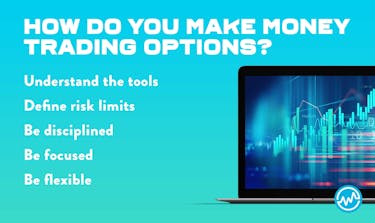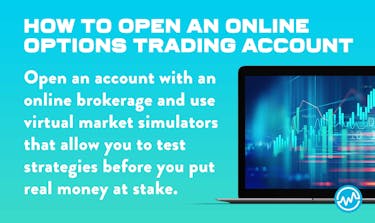

Get Access to 250+ Online Classes
Learn directly from the world’s top investors & entrepreneurs.
Get Started NowIn This Article
I traded options for years. Standing in the Treasury Note Options Pits at the Chicago Board of Trade, I saw sizable amounts of money made (and lost) within minutes.
No two days — or hours — were ever the same. Market conditions can change on a dime, due to economic reports, order flow, or an unexpected tweet.
In addition to having a firm grasp of trading strategies, traders need to be disciplined and nimble when the market makes unexpected moves. As you can imagine, adrenaline runs high and stress can cloud most level-headed minds.
In this article, I’ll answer the question “what is options trading” by explaining the basics of options trading and a few simple strategies. I’ll also touch upon the discipline, patience, and adaptability that increase the chances of success in any market conditions.
Most importantly, since options trading can be complex, I’m going to make it simple so you can understand and decide if it’s the right investment vehicle for you. Ready? Let’s go.
What Is Options Trading?
An option is a contract that gives the buyer the right, but not the obligation, to buy or sell an underlying asset or instrument at a specified strike price prior to or on a specified date, depending on the form of the option.
You may hear options referred to as “derivatives,” which essentially means that they are financial contracts that get their value, risk, and basic term structure from an underlying asset. That underlying asset can be individual stocks, bonds, or ETFs.
When the risks and structure of options are understood, they can be a versatile investment tool that can work in both a bull market (rising prices and optimism) and a bear market (falling prices and pessimism).
While the language and structure of options trading may seem foreign, you’ve probably seen how options strategies work without realizing it.
Before we jump into the strategies, let’s break down the basic terminology of options trading so that you can have a fundamental answer to the question “what is options trading?”
Options Trading Terminology
Calls and Puts
There are two types of options: one that gives you the right to buy the underlying contract, and one that gives you the right to sell the underlying contract.
- A call is an option that offers the right but not the obligation to buy an underlying asset at a certain date for a predetermined price.
- A put is an option that offers the right but not the obligation to sell an underlying asset at a certain date for a predetermined price.
Strike Price (also known as Exercise Price)
The strike price is the price at which you can buy or sell the underlying asset if you choose to exercise the option.
Expiration Date
All options have an expiration date — that is, a date when the options contract becomes void.
On the expiration date, the owner of the option has a choice: elect to exercise the option or allow it to expire worthlessly.
Depending on the terms of the option, the expiration date can be days, weeks, months, or even years into the future.
Premium
There are two components that make up the premium (also known as the price) of an option: the intrinsic value and the extrinsic value.
Intrinsic Value
The intrinsic value is the real, tangible value of an options contract. Let’s take an example of a stock that is trading at $100.
If you own a call option (the right to buy an underlying at a certain price) with a strike price of $80, the intrinsic value of this option is the difference between the market price (for example $100) and the strike price ($80), which is $20.
Not all options have intrinsic value. Using the example above, with a stock that is trading $100, a call option with a price higher than the market value would have an intrinsic value of $0.
That makes sense, right?
At the given moment, with the stock trading $100, you wouldn’t assign any value to the “right” to purchase the stock for, say, $120.
This is where the factors of extrinsic value come into play.
Extrinsic Value
The extrinsic value of an options contract is also known as the premium value or time value. As those terms suggest, this component of the price is determined by fluctuating values such as volatility (market conditions, scarcity) and time until expiration.
The extrinsic component of premium explains why options with no intrinsic value trade at a price higher than zero.
How Do You Make Money Trading Options?

Options trading can be lucrative, but it can also carry a substantial risk of loss.
Like any business, becoming a successful options trader requires a certain amount of foundational knowledge, hard work, and grit.
Here are my 5 takeaways for setting yourself up for success in options trading, based on my experience in the arena.
#1: Understand the tools
As I touched upon earlier, while options trading is complex, there is a myriad of tools and interactive resources available to help both novice and advanced investors effectively use options and volatility strategies to manage risk and achieve their goals.
One of my favorite online resources is The Options Institute at the Chicago Board of Options Exchange.
#2: Define Risk Limits
Before you make your first trade, understand what’s at stake.
Before you put real money at stake, understand the potential downside of your trade and establish the point where you’ll exit the trade (both from a standpoint of profit and of loss).
When you enter into options trades with your eyes wide open and realistic expectations, you’ll be better at managing your trades and, in turn, your risks.
#3: Be Disciplined
Now that you’ve defined your risk limits, you must practice discipline. Why is this important?
In the heat of the moment, when a trade has become better or worse than expected, it’s easy to lose control of emotions and make decisions that are risky.
Traders who are able to make level-headed decisions in the face of chaos are the ones who are able to persevere long-term.
#4: Be Focused
Be aware of factors that will affect your trade and monitor those conditions.
Be aware of order flow in the products you trade — factors such as supply and demand can affect the extrinsic value of options.
It is also crucial for traders to monitor and interpret the news, understanding the difference between hype from reality and making appropriate decisions based upon your risk parameters.
#5: Be Flexible
Not every trade will be a winner. What separates the winners from the losers is the ability to recognize a losing trade and cut losses by exiting the trade.
It’s hard to accept it at the moment, but you will learn from every mistake you make.
As in all areas of life, your ability to shake off adversity and move forward with a clear head will set you up for success in the future.
Next, let’s take a look at the advantages of options trading as well as its disadvantages.
Advantages Of Options Trading
Options are one of the most versatile tools of the financial markets.
Whether the market is moving up, down, or sideways, options allow investors to enter the market with lower cost and lower risk than trading the underlying asset on its own.
Online options trading platforms bring comprehensive trading, investment, and research facilities to individual investors.
Disadvantages Of Options Trading
On the other hand, options trading has a steep learning curve. It takes time to understand the full details of the question “what is options trading?”
Conditions can change quickly, at times making it difficult to close out a position if liquidity is an issue.
Also, depending on the platform you choose, you will have fees associated with each transaction, so make sure to incorporate those costs into your strategies.
As discussed above, investing the time into education and to have a firm grasp of personal risk limits will set up a trader for a better chance of success.
Options Trading Strategies
Now, let’s take a look at some strategies that you can utilize.
Things Are Looking Up: Buying Calls
Earlier, I mentioned that you’ve probably seen how options strategies work without realizing it.
Think about your automobile insurance. Say that you pay $100 each month for this policy. You, of course, hope that you will not incur any automobile repair costs, but you pay your insurance company a monthly premium for the right to lock in a certain amount of protection in case of an unexpected repair bill.
In a month when you have no repairs, the intrinsic value of your insurance policy is zero, but it can be worth thousands in a month when you incur a costly repair.
You can see how this example is much like buying a call. You are paying a premium for the right, but not the obligation, to purchase something at a fixed price, given a spike in pricing.
Look Out Below: Buying Puts
Of course, options strategies can be employed for all expected market movements:
- bull market
- bear market
- stagnancy
When you’re anticipating a fall in the price of your underlying contract but don’t want to take the risk of going short (selling) that contract, purchasing a put can help you capitalize on negative prices.
For example, when a stock is trading $100, an $80 put would give you the right but not the obligation to sell the stock at $80 during a given time period.
At the moment, your option has zero intrinsic value (why would you sell something at $80 when you could sell it at $100?) but, similar to the earlier insurance example, your put gives you protection against a pricing shift to the downside.
Moving and Shaking: Buying Straddles
In both strategies mentioned above, you’re paying a premium to make a bet on the direction (either the rise or fall of the underlying price in a set time period).
What would you do to capitalize on a volatile market period, regardless of direction?
A long straddle is an options strategy where the investor simultaneously purchases a call and put option on the same underlying, with the same strike price and expiration date.
This strategy is used when the investor believes the price of the underlying will move significantly out of range but is unsure of which direction the move will take. In this strategy, the downside is limited to the premium (the price of the straddle).
The loss is realized if the underlying is trading at the strike price at the time of expiration. The gains are realized when the option expires at a price that is far enough away from the strike price to offset the premium of the straddle.
How to Open an Online Options Trading Account

If you want to trade options online, you’ll need to open an account with a brokerage that supports options. There are a wide range of brokerages, such as TD Ameritrade, ETrade, paperMoney by TD Ameritrade and more.
Some of the platforms above actually offer virtual market simulators that allow you to test strategies before you put real money at stake. I strongly recommend you do several mock trades.
What Is Options Trading?
By now, you should have an answer to the question “what is options trading?” — and much more.
As you’ve learned here, while options trading can serve as an investment opportunity, it can also be complex and risky. That’s why I provided an overview of what exactly options are and various platforms to test out simulated trades, risk-free. It’s a continued education
Like I said, standing in the Treasury Note Options Pits at the Chicago Board of Trade, I saw sizable amounts of money made and lost within minutes.
It’s a continued education that gives you the best chance to achieve success in this investment opportunity.






